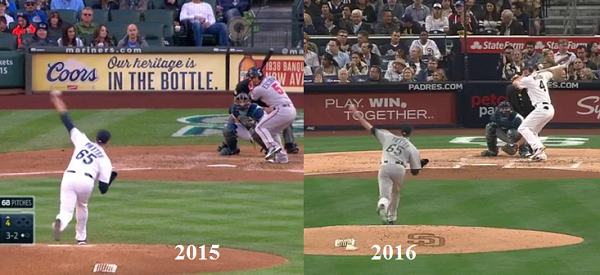James Paxton's Spike in Velocity is Making Him a Whole New Pitcher

James Paxton has been an intriguing prospect for a number of years now. I use the term "prospect" loosely because he’s a 27-year-old pitcher who has four years of MLB experience. Paxton has just 181 MLB innings under his belt, though, and has never thrown 100 big-league innings in a single season.
The picture I’m attempting to illustrate is of a player with exciting potential who has seen his chance at success derailed by recurring injuries.
However, James Paxton’s 2016 season is exciting for an entirely different reason than ever before.
Increased Velocity
If you read the title of this article, there’s a decent chance you can probably guess where I’m going with this. Lo and behold, Paxton’s newfound success comes on the heels of a mechanical adjustment that has led to a massive spike in the average velocity of all his pitches, especially his fastball, as you can see in this chart via Brooks Baseball.

Southpaws who throw hard are rare; lefties who touch 100 miles per hour and average 97-plus throughout an outing are almost unheard of. That’s why Paxton is suddenly fascinating.
This is James Paxton's annual fastball velo (not including tonight), and it makes me laugh. pic.twitter.com/yBcdxZ6IPD
— Mike Petriello (@mike_petriello) June 7, 2016
He began the season in Triple-A Tacoma, where his pitching coach, Lance Painter, suggested a change in arm slot, according to Shannon Drayer of 710 ESPN in Seattle.
“I was getting way too high on the front side,†Paxton said. “It wasn’t a point of strength for me to throw from.â€
To illustrate the point, Painter had Paxton field a ground ball and throw it to first base. That, he told Paxton, was his natural arm slot. Paxton discovered that once he was able to repeat it, he had more success hitting the inside corner, which opened up the outside for him.
These adjustments are evident when you look at a side-by-side comparison of the two release points as fleshed out by FanGraphs' Eno Sarris.

This year’s Paxton looks much more natural. Over his last two starts, he's thrown 12.1 innings and compiled 17 strikeouts while limiting opponents to just 3 walks. Over those two games, he has a 0.73 ERA (allowing just 1 earned run) and a 1.14 WHIP.
This isn't to suggest that Paxton is suddenly an ace, but it does seem that these changes to his throwing motion support the positives we're now seeing.
Injuries have always been the biggest question with Paxton, but he should be valuable for as long as he’s healthy, and it’s time to pick him up in fantasy while he’s dealing.
















